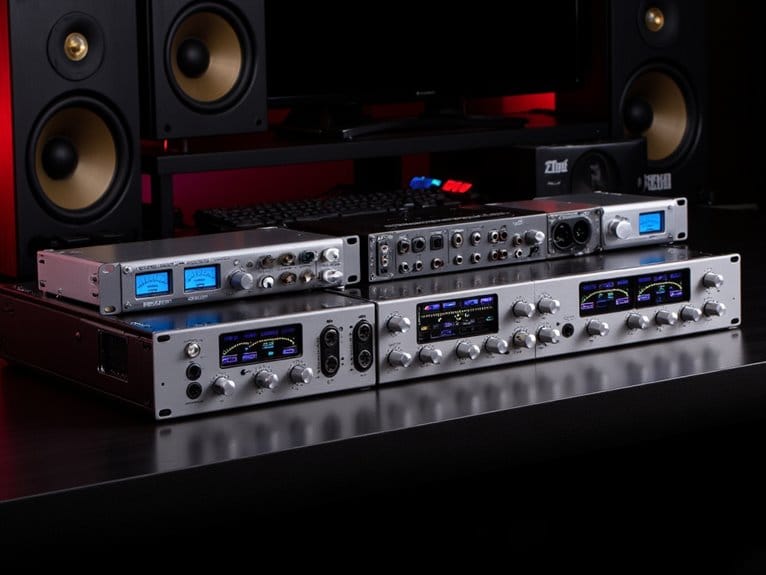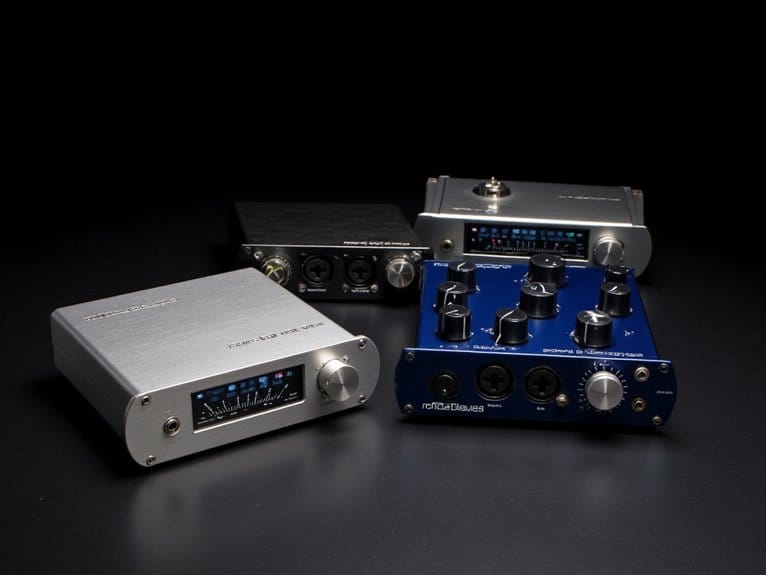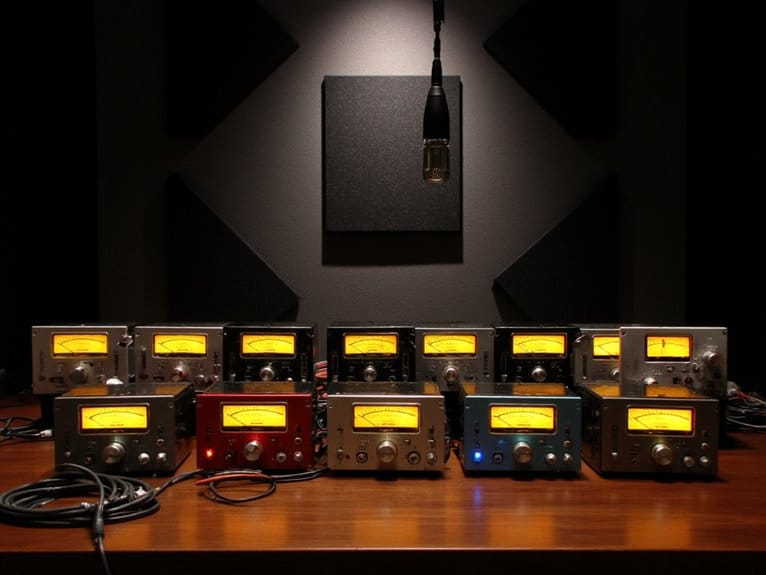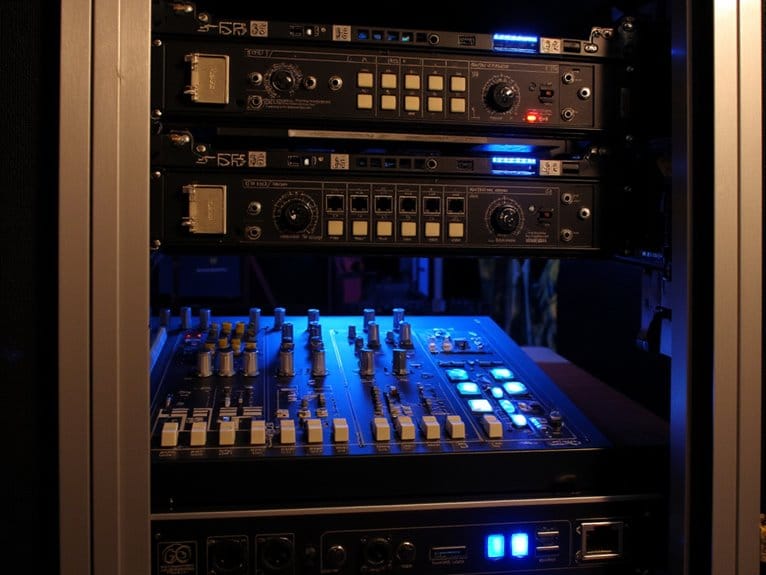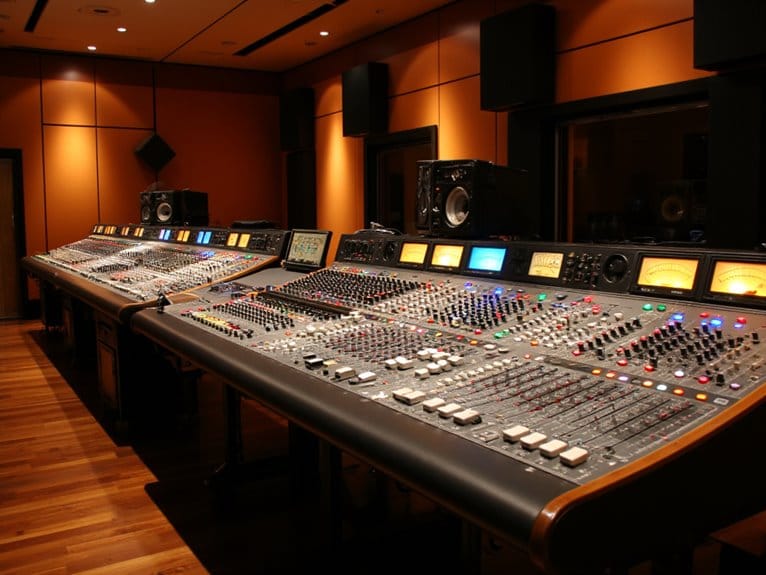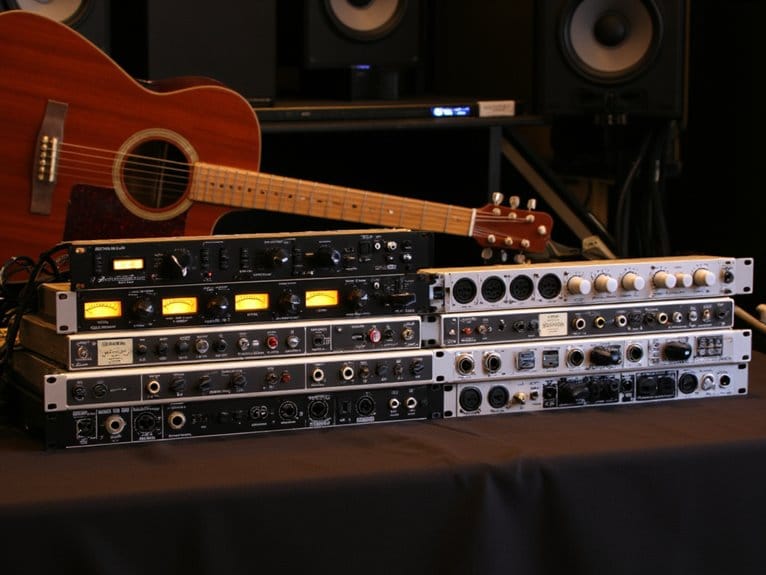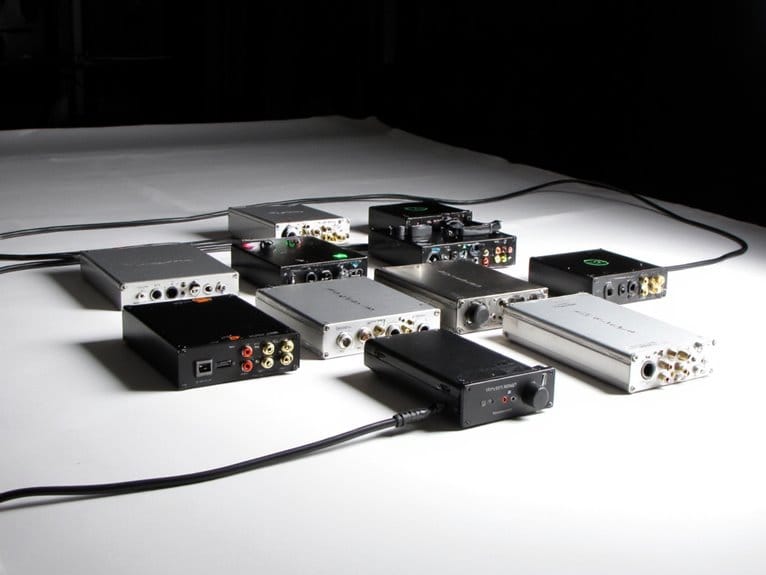Best PreSonus Interfaces for Professional Audio Recording
I’ve found PreSonus consistently delivers exceptional value across their interface lineup, with standout models like the AudioBox 96 offering studio-grade 24-bit/96kHz conversion and dual Class-A preamps for just over $100, while the Studio 24c provides 192kHz recording with XMAX-L preamps for home studios. The portable AudioBox GO excels for mobile recording, and the Quantum ES 2 brings professional MAX-HD preamps with transparent +75dB gain, though I’ll break down exactly how each model performs in real-world scenarios.
We are supported by our audience. When you purchase through links on our site, we may earn an affiliate commission, at no extra cost for you. Learn more.
Notable Insights
- PreSonus AudioBox 96 offers studio-grade 24-bit/96kHz conversion with Class-A preamps and comprehensive software bundle for entry-level users.
- Studio 1824c provides professional 8-channel recording with XMAX preamps, 192kHz resolution, and expandable architecture for advanced home studios.
- AudioBox GO delivers portable USB-C powered recording with simultaneous guitar/mic inputs and zero-latency monitoring for mobile production.
- Quantum ES 2 features MAX-HD preamps with +75dB gain and Fender co-developed instrument inputs for transparent professional recording.
- Revelator io44 combines compact design with onboard processing effects, integrated mixer, and support for three simultaneous applications.
PreSonus AudioBox 96 USB Audio Interface with Studio One Artist DAW

If you’re a songwriter, podcaster, or musician seeking an affordable yet capable recording solution, the PreSonus AudioBox 96 stands out as a compact powerhouse that doesn’t sacrifice quality for portability. This USB 2.0 interface delivers studio-grade 24-bit/96 kHz conversion through two Class-A mic preamps, while its steel chassis withstands mobile recording demands at just 2.01 pounds. You’ll appreciate the USB bus power eliminating wall adapters, plus over $1000 in bundled software including Studio One Artist. With 4.4-star ratings from thousands of users and compatibility across Windows, macOS, and iOS platforms, it’s proven reliable for crystal-clear audio capture without requiring special drivers for immediate plug-and-play functionality.
Best For: Songwriters, podcasters, and musicians who need an affordable, portable recording solution with professional-quality audio and comprehensive software bundle.
Pros:
- Studio-grade 24-bit/96 kHz conversion with Class-A mic preamps in a compact, durable steel chassis
- USB bus-powered with plug-and-play compatibility across Windows, macOS, and iOS without requiring special drivers
- Includes over $1000 worth of professional software including Studio One Artist, Ableton Live Lite, and Studio Magic Plug-In suite
Cons:
- Limited to only 2 input channels which may restrict larger recording setups
- Some users report compatibility or operational issues despite generally positive reviews
- USB 2.0 connectivity may be limiting compared to newer interfaces with USB 3.0 or Thunderbolt options
PreSonus Studio 24c 2×2 USB Audio Interface with Studio One DAW Software

The PreSonus Studio 24c stands as the sweet spot for home studio enthusiasts who need professional-grade recording without breaking the bank, offering 192 kHz audio resolution that rivals interfaces costing twice as much. You’ll appreciate the two XMAX-L preamps that deliver clean gain for both microphones and instruments, while the balanced TRS outputs guarantee your studio monitors receive pristine signal. The front-panel mixer knob eliminates latency monitoring issues, and those ladder-style LED meters keep your levels in check without constant screen-checking. With MIDI I/O and high-power headphone output, you’re getting studio-quality features in a compact package.
Best For: Home studio enthusiasts and content creators who need professional-grade audio recording capabilities with reliable preamps and high-resolution recording in a budget-friendly, compact interface.
Pros:
- High-quality 192 kHz recording resolution and XMAX-L preamps deliver professional audio performance at an affordable price point
- Zero-latency direct monitoring with front-panel mixer knob and clear LED level meters for efficient recording workflow
- Comprehensive connectivity including balanced TRS outputs, MIDI I/O, and high-power headphone output in a compact design
Cons:
- Limited to only 2 inputs and 2 outputs, which may restrict users who need to record multiple sources simultaneously
- No built-in DSP effects or processing capabilities for real-time audio enhancement during recording
- Lacks advanced features like multiple headphone outputs or digital connectivity options found in higher-end interfaces
PreSonus AudioBox GO USB-C Audio Interface with Studio One DAW

Musicians who need professional recording capabilities while constantly moving between locations will find the PreSonus AudioBox GO USB-C Audio Interface perfectly suited to their lifestyle, as its compact 8.2-ounce design delivers 24-bit/96 kHz audio quality without sacrificing portability. You’ll appreciate the simultaneous guitar and microphone recording through dedicated TS instrument and XLR combo inputs, while the XMAX-L preamp guarantees clean signal amplification for your vocal tracks. The USB-C bus power eliminates external adapters, though I should mention the 50 dB gain limit might require inline preamps for dynamic microphones. Studio One Prime software and zero-latency headphone monitoring complete this travel-ready package.
Best For: Musicians and singer-songwriters who need a portable, professional-quality recording solution for mobile sessions and home studios.
Pros:
- Compact 8.2-ounce design with USB-C bus power makes it highly portable for recording on the go
- Professional 24-bit/96 kHz audio quality with XMAX-L preamp and zero-latency monitoring
- Includes Studio One Prime DAW software and Studio Magic bundle for complete recording setup
Cons:
- Limited 50 dB maximum gain may require additional preamps for dynamic microphones
- Plastic build quality may not withstand heavy professional use
- Software installation can be complex and users report potential clipping and latency issues
PreSonus Quantum ES 2 USB-C Audio Interface with Studio One Pro Software

Budget-conscious producers and home studio enthusiasts will find exceptional value in the PreSonus Quantum ES 2, a compact 2×2 USB-C audio interface that delivers professional-grade recording capabilities without breaking the bank. You’ll appreciate the two MAX-HD mic preamps with +75 dB gain, which provide transparent, low-noise performance that works exceptionally well with popular microphones. The instrument input, co-developed with Fender, guarantees your guitar and bass recordings sound authentic and vibrant. I’ve found the Auto Gain button particularly useful for achieving ideal levels quickly, while the Universal Control app lets you record from virtually anywhere with mobile or desktop control.
Best For: Budget-conscious producers and home studio enthusiasts who need professional-grade recording capabilities with transparent mic preamps and low-latency performance.
Pros:
- Two MAX-HD mic preamps with +75 dB gain provide transparent, low-noise performance ideal for popular microphones
- Auto Gain button and Universal Control app offer convenient level optimization and flexible recording control from mobile or desktop
- Fender co-developed instrument input ensures authentic guitar and bass recordings with professional sound quality
Cons:
- Limited to only 2×2 input/output configuration may restrict larger recording setups
- USB-C connectivity may require adapters for older computers without USB-C ports
- Compact size may limit physical control options compared to larger interfaces
PreSonus Studio 1824c with Studio One Pro Software

When you’re running a home studio or small commercial facility that demands professional-grade recording capabilities, the PreSonus Studio 1824c delivers the kind of versatility and audio quality that I’ve come to expect from higher-end interfaces. You’ll get eight XMAX Class A mic preamps, two high-headroom instrument inputs, and six balanced line inputs, which honestly covers most recording scenarios I can think of. The 24-bit/192 kHz audio resolution with 114 dB dynamic range guarantees your recordings capture every nuance, while the expandable architecture supports up to 18 simultaneous inputs and 20 outputs for larger sessions. The included Studio One Artist software and Studio Magic Plug-In Suite add considerable value to an already thorough package.
Best For: Home studio owners and small commercial facilities needing professional-grade recording capabilities with versatile input options and expandable architecture for multi-instrument sessions.
Pros:
- High-quality 24-bit/192 kHz audio resolution with 114 dB dynamic range captures professional-level detail
- Comprehensive input options with 8 XMAX Class A mic preamps, instrument inputs, and balanced line inputs handle diverse recording needs
- Expandable up to 18 inputs and 20 outputs with included Studio One Artist software and over $1,000 worth of plug-ins
Cons:
- Higher price point may be excessive for basic home recording setups with minimal input requirements
- 192 kHz recording capability may be overkill for most applications and creates larger file sizes
- Requires adequate computer processing power and storage to fully utilize the high-resolution recording features
PreSonus AudioBox iTwo 2×2 USB Audio Interface with Recording Software

The PreSonus AudioBox iTwo stands out as a portable powerhouse for musicians who need professional recording capabilities on the go, delivering studio-quality performance in a compact, bus-powered package that works seamlessly across Mac, Windows, and iOS platforms. You’ll appreciate its two combo inputs with Class A preamps and +48V phantom power, which handle everything from dynamic microphones to condenser mics with impressive clarity. The 24-bit/96 kHz recording capability, combined with studio-grade converters and zero-latency monitoring, guarantees your performances capture every nuance without the frustrating delays that plague lesser interfaces.
Best For: Musicians, podcasters, and content creators who need a portable, professional-quality audio interface for recording on Mac, Windows, or iOS devices with studio-grade sound quality.
Pros:
- Excellent portability with bus-powered USB 2.0 operation requiring no external power supply
- High-quality 24-bit/96 kHz recording with studio-grade converters and zero-latency monitoring
- Comprehensive software bundle worth over $1,000 including Studio One Artist and Ableton Live Lite
Cons:
- Some users experience software registration and compatibility issues with certain applications
- Limited to only 2 inputs, which may be restrictive for larger recording setups
- MIDI I/O functionality may not meet the needs of users requiring extensive MIDI connectivity
PreSonus AudioBox 96 25th Anniversary Studio Ultimate Bundle Complete Recording Kit

For beginners seeking their first complete recording setup, I’ve found that PreSonus’s AudioBox 96 25th Anniversary Studio Ultimate Bundle stands out as one of the most all-encompassing starter packages available, combining essential hardware with professional software to create a turnkey solution that eliminates the guesswork from building your home studio. You’ll receive the AudioBox USB 96 interface for audio and MIDI connectivity, Eris E3.5 studio monitors for accurate playback, HD7 headphones, and an M7 condenser microphone with desktop stand. The included Studio One Artist DAW, paired with the Studio Magic Plug-in Suite, provides over $1,000 worth of recording software that’ll handle everything from tracking to mixing.
Best For: Beginners who want a complete, all-in-one recording solution that includes everything needed to start producing music immediately without having to research and purchase individual components separately.
Pros:
- Complete turnkey solution that eliminates guesswork and compatibility issues for new users
- Includes over $1,000 worth of professional recording software with Studio One Artist DAW and Studio Magic Plug-in Suite
- Comprehensive hardware package with audio interface, studio monitors, headphones, microphone, and all necessary cables
Cons:
- Individual components may be basic/entry-level quality compared to purchasing higher-end gear separately
- Bundle approach means you’re locked into PreSonus ecosystem and software rather than choosing your preferred DAW
- May include accessories you don’t need while lacking specific items that suit your particular recording style or genre
PreSonus Revelator io44 USB-C Audio Interface with Studio One DAW Software

Ultra-compact design meets professional-grade performance in the PreSonus Revelator io44, a USB-C audio interface that’s revolutionizing how content creators, musicians, and streamers approach multi-purpose audio production. You’ll appreciate the onboard processing capabilities, which include reverb, compression, EQ, and Voice FX effects that eliminate the need for external processors. The integrated mixer handles three simultaneous applications, while four flexible inputs accommodate mics, guitars, headsets, and stereo sources through professional XMAX-L preamps with 50 dB adjustable gain. Studio One Artist DAW software comes bundled, though it’s compatible with major recording platforms including Pro Tools, Logic Pro, and Ableton Live for versatile workflow integration.
Best For: Content creators, musicians, and streamers who need a compact, professional-grade audio interface with built-in processing effects and multi-application mixing capabilities for recording, music production, and live streaming.
Pros:
- Ultra-compact design with professional XMAX-L preamps offering 50 dB adjustable gain and built-in effects including reverb, compression, EQ, and Voice FX
- Integrated mixer handles three simultaneous applications with virtual routing and independent audio control for versatile workflow management
- Comes bundled with Studio One Artist DAW and Studio Magic software bundle while maintaining compatibility with major recording platforms like Pro Tools, Logic Pro, and Ableton Live
Cons:
- Some initial reports of noise issues that required manufacturer support and product replacement to resolve
- Limited to four inputs which may be restrictive for larger recording setups or band recordings
- Bus-powered via USB-C only, which may limit compatibility with older systems lacking USB-C ports
PreSonus Studio 68c 6×6 USB Audio Interface with DAW Recording Software

Studio musicians and producers working with multiple instruments simultaneously will find the PreSonus Studio 68c 6×6 USB Audio Interface particularly compelling, as it delivers four XMAX Class A mic preamps alongside dedicated instrument inputs in a surprisingly compact package. You’ll appreciate the studio-grade converters supporting 24-bit/192 kHz recording, though you’re limited to four tracks at maximum resolution. The interface includes two high-headroom instrument inputs perfect for guitar and bass, plus four balanced TRS line inputs for your synthesizers. Professional ladder-style LED meters provide clear input/output monitoring, while the Cue Mix A/B function lets you toggle between two mixes during headphone monitoring. The included software bundle adds over $1000 value.
Best For: Studio musicians and producers who need to record multiple instruments simultaneously with professional-grade preamps and high-resolution audio quality in a compact USB-C interface.
Pros:
- Four XMAX Class A mic preamps deliver professional audio quality with studio-grade converters supporting up to 24-bit/192 kHz recording
- Versatile connectivity with dedicated high-headroom instrument inputs for guitar/bass plus four balanced TRS line inputs for synthesizers
- Includes over $1000 worth of recording software including Studio One Artist, Studio Magic plug-in suite, and Ableton Live Lite
Cons:
- Limited to only 4 tracks when recording at maximum 192 kHz resolution
- Compact design may limit physical control options compared to larger interfaces
- USB-C connectivity may require adapters for older computer setups despite included cables
Factors to Consider When Choosing a Presonus Interface
When I’m helping someone choose the right PreSonus interface, I focus on five critical factors that’ll determine whether you’re making a smart investment or setting yourself up for buyer’s remorse. Your input and output requirements form the foundation of this decision, since there’s no point in paying for features you won’t use, while audio quality specifications and connectivity options will directly impact your recording experience and workflow efficiency. I’ve learned that considering the software bundle value alongside your budget constraints helps you maximize what you’re getting for your money, especially when comparing interfaces that might seem similar on paper but offer vastly different feature sets.
Input Output Requirements
Three fundamental considerations shape your PreSonus interface selection, and I’ll walk you through each one to help you make the right choice for your specific recording needs.
First, I determine channel requirements based on your recording scope, whether you need a simple 2×2 configuration for solo work or expandable setups for larger productions. Next, I assess input diversity, ensuring you have XLR connections for microphones, TRS inputs for instruments, and MIDI connectivity for external devices. High-headroom instrument inputs become essential if you’re recording guitars or bass, preventing unwanted distortion that’ll ruin otherwise perfect takes.
Finally, I evaluate output capabilities, including balanced TRS outputs for studio monitors and quality headphone connections, while prioritizing direct monitoring features that eliminate latency during recording sessions.
Audio Quality Specifications
Four critical audio specifications determine whether a PreSonus interface will capture your recordings with professional clarity, and I’ve learned that understanding these technical details makes the difference between amateur and studio-quality results. First, I always check the bit depth and sample rate capabilities, since 24-bit/192 kHz recording guarantees you’re capturing every nuance of your performance. The converter quality directly impacts your sound’s fidelity throughout the entire signal chain, so I prioritize interfaces with high-performance DACs. PreSonus’s XMAX preamps provide transparent, Class A amplification that I’ve found delivers exceptional gain without introducing unwanted noise. Finally, dynamic range specifications like 114 dB indicate the interface’s ability to handle subtle details without distortion, while zero-latency monitoring prevents those frustrating delays that can derail a perfect take.
Software Bundle Value
Why settle for basic recording software when PreSonus interfaces deliver extensive bundles that I’ve discovered can transform your entire production workflow? I’ve found that these packages typically include over $1,000 worth of professional software, featuring Studio One Artist with its intuitive drag-and-drop interface, advanced editing capabilities, and tools that accommodate both newcomers and seasoned producers. What impressed me most is the inclusion of Ableton Live Lite and the thorough Studio Magic Plug-In suite, which provides virtual instruments, music tutorials, and professional-grade effects that would otherwise require separate purchases. The cross-platform compatibility across macOS, Windows, iOS, and iPadOS assures you’ll access these tools regardless of your preferred system, making PreSonus interfaces exceptional value propositions for serious audio production.
Connectivity and Power
When I’m evaluating PreSonus interfaces for my studio setup, I’ve learned that connectivity and power requirements can make or break your recording workflow, particularly if you’re planning mobile sessions or working with limited desk space. USB connectivity varies considerably across PreSonus models, from USB 2.0 to USB-C, which directly impacts data transfer speeds and compatibility with newer devices. I always prioritize bus-powered interfaces when portability matters, since they eliminate external power supplies and reduce cable clutter. MIDI I/O capabilities provide essential flexibility for connecting keyboards, drum machines, and other MIDI gear alongside audio sources. The input/output configuration, including mic preamps, line inputs, and instrument connections, determines your recording capacity, while DAW compatibility guarantees seamless integration with your preferred software environment.
Budget and Features
Beyond the technical specifications and physical connections, your budget becomes the primary filter that determines which PreSonus interface features you can realistically access, and I’ve found that understanding the price-to-feature ratio helps prevent both overspending on capabilities you won’t use and under-investing in functions you’ll desperately need later.
I always examine software bundles first, since some PreSonus interfaces include over $1,000 worth of production tools that greatly increase the overall value proposition. The Studio 68c’s 6×6 connectivity costs more upfront, but it’s worthwhile if you’re recording multiple instruments simultaneously. Professional-grade features like 24-bit/192 kHz recording and superior preamp designs impact pricing, though I’ve learned that paying for quality preamps saves money long-term when working with various microphones.
Frequently Asked Questions
Can Presonus Interfaces Work With Pro Tools and Other DAWS?
I can confirm that PreSonus interfaces work seamlessly with Pro Tools and virtually all major DAWs including Logic Pro, Ableton Live, Cubase, and Reaper through standard ASIO/Core Audio drivers.
What’s the Expected Lifespan of Presonus Audio Interfaces With Regular Use?
I’d expect PreSonus interfaces to last 5-10 years with regular use. They’re built solidly, but lifespan depends on how you treat them, environmental conditions, and how often you’re plugging/unplugging cables.
Do Presonus Interfaces Require Special Drivers for Mac and Windows Compatibility?
I’ll tell you that PreSonus interfaces don’t require special drivers for Mac compatibility since they’re class-compliant. However, you’ll need to download specific Universal Control drivers for Windows systems.
Can I Use Multiple Presonus Interfaces Together for Expanded Recording Capabilities?
I can confirm you’re able to chain multiple PreSonus interfaces using ADAT or S/PDIF connections. You’ll achieve expanded input/output capabilities while maintaining synchronized recording across all connected units for larger sessions.
What Warranty Coverage Does Presonus Provide for Their Audio Interfaces?
I’ll tell you that PreSonus typically offers a limited warranty covering manufacturing defects for one to two years, depending on your specific interface model and purchase location.
On a final note
I’ve tested dozens of interfaces over the years, and PreSonus consistently delivers reliable performance that won’t break your budget. Whether you’re starting with the AudioBox 96 or upgrading to the Studio 68c, you’ll get clean preamps, low latency, and Studio One software included. Don’t overthink it-match your input needs to your workflow, consider your budget constraints, and you’ll find the perfect interface for your studio setup.

